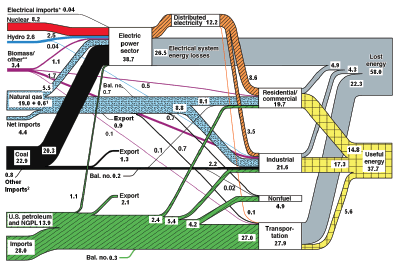
About the Class
U.S. energy from sources to end uses, 2001 [EIA]
8.21 — “The Physics of Energy” — has been offered each Fall semester since 2008. The course was developed by physics faculty members Robert L. Jaffe and Washington Taylor. The course is designed for MIT sophomores, juniors, and seniors who want to understand the fundamental laws and physical processes that govern the sources, extraction, transmission, storage, degradation, and end uses of energy. The course should be accessible to any MIT student who has completed the physics, math, and chemistry components of the GIR’s.
8.21 is not aimed specifically at physics majors. It is designed for any MIT student, including, for example, an engineer, scientist, social scientist, or management, architecture or planning major, who wants to get a firm foundation in the physical principles that constrain the energy landscape. The course will enable students to approach energy issues in a sophisticated and scientific fashion, but without having to take advanced subjects in thermodynamics, quantum mechanics, or nuclear physics beforehand. Hence the prerequisites for 8.21 are based on the General Institute Requirements: 8.01, 8.02, 18.01, 18.02, and 5.11x or 3.091 — nothing more.
If you are thinking about taking 8.21, there are a few things you should know about the course...
-
Although 8.21 provides a global perspective on energy systems, it is not a superficial survey course. 8.21 focuses on the fundamental physical principles underlying energy processes, and on application of these principles to practical calculations. We emphasize quantitative analysis and introduce and apply many important analytical tools.
-
8.21 focuses on the science of energy. Tough political, economic, social, and ethical issues have to be resolved to provide the world with abundant energy from clean and sustainable sources. Although they are not discussed directly in 8.21, the course provides the scientific foundation for intelligent evaluation of those important considerations.
-
If you are interested in studying any particular energy technology in great depth, you want to take additional, more advanced subjects at MIT. Our hope is that 8.21 gives you enough background to approach those subjects with a broad and functional perspective on the physics of energy.
Rather than follow the traditional Course VIII format of theory followed by application, we integrate scientific theory with practical applications to energy systems of contemporary relevance throughout the semester. If you complete this subject you should be equipped with the technical tools and perspective to enable you to start to evaluate energy choices objectively and quantitatively both at a national policy and a personal level.
Survey courses on energy issues or on
the science of energy offered at many other
universities are aimed at non-scientists without a
background in calculus or calculus-based
physics. Because MIT undergraduates are so well
prepared in mathematics and physics, we present
material at a considerably more advanced
level. This should make the course more exciting (and more challenging). Much of the
reading and background
material for 8.21 has been
created specifically for
this course.
If you have questions about the style, content, prerequisites, or other details of
8.21, please contact
us
.
To view a list of topics and tentative schedule for the subject, click here.
